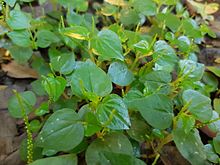Peperomia pellucida
| Peperomia pellucida | |
|---|---|

| |
| Scientific classification | |
| Kingdom: | Plantae |
| Clade: | Tracheophytes |
| Clade: | Angiosperms |
| Clade: | Magnoliids |
| Order: | Piperales |
| Family: | Piperaceae |
| Genus: | Peperomia |
| Species: | P. pellucida
|
| Binomial name | |
| Peperomia pellucida | |
| Synonyms | |
|
Piper concinnum Haw. | |
Peperomia pellucida (also known by common names pepper elder, shining bush plant, and man to man) is an annual, shallow-rooted herb, usually growing to a height of about 15 to 45 cm. it is characterized by succulent stems, shiny, heart-shaped, fleshy leaves and tiny, dot-like seeds attached to several fruiting spikes. It has a mustard-like odor when crushed. The family Piperaceae comprises about a dozen genera and around 3000 species. The genus Peperomia represents nearly half of the Piperaceae with the genus Piper making the rest.
Habitat
Flowering year-round, the plant is found in various shaded, damp habitats all over Asia and the Americas. It grows in clumps, thriving in loose, humid soils and a tropical to subtropical climate.
Uses
Peperomia pellucida has been used as a food item as well as a medicinal herb. Although mostly grown for its ornamental foliage, the entire plant is edible, both cooked and raw. It is also said that it can be a good refrigerant.
Pharmacology
The analgesic properties of the plant seem to be related to its effect on prostaglandin synthesis.[1] It may have potential as a broad spectrum antibiotic, as demonstrated in tests against Staphylococcus aureus, Bacillus subtilis, Pseudomonas aeruginosa, and Escherichia coli.[2] Chloroform extracts from dried leaves of P. pellucida have been shown to exhibit antifungal activity against Trichophyton mentagrophytes in vitro.[3]
Anti-inflammatory activity (in paw edema) and analgesic activity has been demonstrated in rats and mice.[4]
Although the plant can cause asthma-like symptoms in patients with known hypersensitivity reactions to the species, no clinical data have yet been reported on human toxicity.
Traditional medicine
Ethnomedicinal uses for the plant vary. P. pellucida has been used for treating abdominal pain, abscesses, acne, boils, colic, fatigue, gout, headache, renal disorders, and rheumatic joint pain.[5][6] In Bolivia, Alteños Indians use the whole plant to stop hemorrhages.[citation needed] The roots are used to treat fevers and the aerial parts are used as dressing for wounds.[7] In northeastern Brazil, the plant has been used to lower cholesterol.[8] In Guyana and the Amazon region, it is a popular cough suppressant, emollient, and diuretic.[citation needed] It is also used to treat proteinuria.[9][10] In the Philippines, a decoction of the plant is used to decrease uric acid levels and to treat renal problems.[citation needed] It is also used topically for skin disorders such as acne and boils.[citation needed]
Common names
It is known as pepper elder, silverbush, rat-ear, man-to-man, clearweed (North America); prenetaria (Puerto Rico); konsaka wiwiri (Suriname); coraçãozinho or "little heart" (Brazil); lingua de sapo, herva-de-vidro, herva-de-jaboti or herva-de-jabuti (South America), corazón de hombre (Cuba).[11] In Oceania, it is called rtertiil (Belauan); podpod-lahe or potpopot (Chamorro). In the different dialects of the Philippines, it is called pansit-pansitan or ulasimang-bato (Tagalog), olasiman ihalas (Bisaya), sinaw-sinaw or tangon-tangon (Bikol), lin-linnaaw (Ilocano) and "clavo-clavo" (Chavacano). In other parts of Asia, it is known as càng cua (Vietnam); pak krasang ผักกระสัง (Thailand); "krasang teap" ក្រសាំងទាប (Cambodia); suna kosho (Japan); rangu-rangu, ketumpangan or tumpang angin (Bahasa/Malay); rinrin (Nigeria), "shining bush" (Trinidad and Tobago), and mashithanduമഷിത്തണ്ട്, വെള്ളത്തണ്ട് and വെള്ളപ്പച്ചില' (Malayalam).In west Bengal,India the plant is locally known as "Luchi pata ".
References
- ^ Aziba PI; Adedeji A; Ekor M; Adeyemi O (2001). "Analgesic activity of Peperomia pellucida aerial parts in mice". Fitoterapia. 72 (1): 57–58. doi:10.1016/S0367-326X(00)00249-5. PMID 11163942.
- ^ Bojo AC; Albano-Garcia E; Pocsidio GN (1994). "The antibacterial activity of Peperomia pellucida (L.) HBK (Piperaceae)". Asia Life Sci. 3: 35–44.
- ^ Ragasa CY; Dumato M; Rideout JA (1998). "Antifungal compounds from Peperomia pellucida". ACGC Chem Res Commun. 7: 54–61.
- ^ Maria de Fátima Arrigoni-Blank, et al. (2004), Anti-inflammatory and analgesic activity of Peperomia pellucida (L.) HBK (Piperaceae)
- ^ Khan MR , Omoloso AD . Antibacterial activity of Hygrophila stricta and Peperomia pellucida . Fitoterapia . 2002;73:251-254.
- ^ Aziba PI , Adedeji A , Ekor M , Adeyemi O . Analgesic activity of Peperomia pellucida aerial parts in mice . Fitoterapia . 2001;72:57-58
- ^ Muñoz V , Sauvain M , Bourdy G , et al. A search for natural bioactive compounds in Bolivia through a multidisciplinary approach: Part III. Evaluation of the antimalarial activity of plants used by Alteños Indians . J Ethnopharmacol . 2000;71:123-131
- ^ Bayma JD , Arruda MS , Müller AH , Arruda AC , Canto WC . A dimeric ArC 2 compound from Peperomia pellucida . Phytochemistry . 2000;55:779-782.
- ^ Arrigoni-Blank Mde F , Oliveira RL , Mendes SS , et al. Seed germination, phenology, and antiedematogenic activity of Peperomia pellucida (L.) H. B. K. BMC Pharmacol . 2002;2:12-19.
- ^ de Fatima Arrigoni-Blank M , Dmitrieva EG , Franzotti EM , Antoniolli AR , Andrade MR , Marchioro M . Anti-inflammatory and analgesic activity of Peperomia pellucida (L.) HBK (Piperaceae) . J Ethnopharmacol. 2004;91:215-218.
- ^ Roig y Mesa, Juan Tomás (1962). Diccionario Botánico de Nombres Vulgares Cubanos Tomo I 3ª edición. La Habana:Instituto Nacional de Reforma Agraria.
External links
- Peperomia pellucida (L.) Kunth , United States Department of Agriculture
- Peperomia pellucida in West African plants – A Photo Guide.
